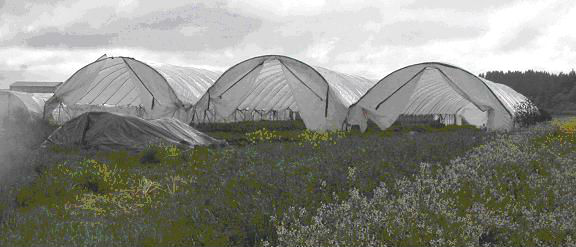Oct 24, 2018NRCS high tunnel investment hits $4.4 million in California
For Scrivner Hoppe-Glosser, a small farmer in Pleasant Grove, Calif., he can’t help but beam at the newest thing to pop up in his farm field. It isn’t one of his 40 different specialty crops that he grows for popular restaurants in the Sacramento area but a structure made of wood, metal and plastic tarping.
“When I first heard that NRCS could help me install a high tunnel, I applied but didn’t really believe that it would happen,” said Hoppe-Glosser. “But then it did. I couldn’t be happier. This high tunnel will help me extend my growing season so we can grow more crops and generate a full year’s income from our farm.” With the help of the USDA Natural Resources Conservation Service (NRCS) and their high tunnel conservation practice, Hoppe-Glosser has achieved his goal.
NRCS in California began assisting farmers with high tunnels, sometimes referred to as hoop houses, in the 2008 Farm Bill and the conservation practice’s popularity has only skyrocketed throughout the 2014 Farm Bill. In Fiscal Year 2014, NRCS provided approximately $400,000 to assist farmers to install the structures. This past fiscal year, 2018, NRCS provided $1.4 million to new farmers to install the same practice. Over a five-year span, NRCS provided $4.4 million in total.
Similar to Hoppe-Glosser, Tong Vue of Beyond Bok Choy farm in Fresno, Calif., was attracted to NRCS’s high tunnel practice because it would allow her to grow more Asian crops, year round, protected by winter’s elements. It is not uncommon to see at least four different crops growing inside her high tunnel at any point in the year, especially basil which typically has a short growing season.
And not limited to just certain regions like California’s Central Valley, high tunnels are effective in arid regions as well. When Kyung Pil-Kim and his wife Mary finished long careers in uber-urban Los Angeles, they were ready for something different — and they got it. They started a jujube farm on 20 acres of high desert in Lucerne Valley near Victorville, Calif.
The first practice they worked with NRCS on was to install a hoop house. “The opportunity is to diversify beyond jujubes to squash, tomatoes, peppers, herbs, tender lettuces, chard and kale —things that could never withstand the desert’s brutal sun and wind,” said Pil-Kim.
High tunnels have created a niche for smaller farming operations and historically underserved landowners who had not previously taken advantage of Farm Bill programs. The high tunnel frame must be constructed of metal, wood, or durable plastic; and be at least six feet in height at the peak of the structure. The covering must be either polyethylene, polycarbonate, plastic, or fabric.
Since its inception in 1935, NRCS has worked in partnership with private landowners and a variety of local, state and federal conservation partners to deliver conservation based on specific, local needs. Please visit www.ca.nrcs.usda.gov for more information about NRCS.
– Jonathan Groveman, NRCS















